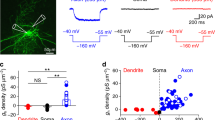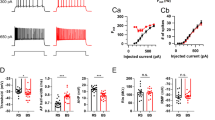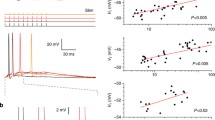Abstract
In this study two-photon imaging and single cell electrophysiological measurements were carried out in PV+ hippocampal interneurons to compare the dendritic calcium dynamics of somatically evoked backpropagating action potentials (BAPs) and in vitro sharp wave oscillation (SPW) activated BAPs at different distances from the soma. In the case of 300 μm thick, non-oscillating slices, the BAP-evoked Ca2+ (BAP-Ca2+) influx propagated along the dendritic tree in a non-uniform manner and its amplitude gradually reduced when measured at more distal regions. In contrast to the evoked BAP-Ca2+s, the spontaneous SPW-induced Ca2+ influx had only a small distance-dependent decrement. Our results suggest that similarly to nicotinic acetylcholine receptor activation, synaptic activity during hippocampal SPWs increases AP backpropagation into distant dendritic segments. Bath application of Nimodipine, a specific Ca2+ channel blocker and tetrodotoxine decreased the amplitude of the somatically evoked Ca2+ influx, which suggests that L-type Ca2+ channels play an important role both during somatically evoked and SPW-induced BAPs.





Similar content being viewed by others
References
Markram H, Lubke J, Frotscher M et al (1997) Regulation of synaptic efficacy by coincidence of postsynaptic APs and EPSPs. Science 275:213–215
Hausser M, Spruston N, Stuart GJ (2000) Diversity and dynamics of dendritic signaling. Science 290:739–744
Xiong W, Chen WR (2002) Dynamic gating of spike propagation in the mitral cell lateral dendrites. Neuron 34:115–126
Rozsa B, Zelles T, Vizi ES et al (2004) Distance-dependent scaling of calcium transients evoked by backpropagating spikes and synaptic activity in dendrites of hippocampal interneurons. J Neurosci 24:661–670
Vetter P, Roth A, Hausser M (2001) Propagation of action potentials in dendrites depends on dendritic morphology. J Neurophysiol 85:926–937
Goldberg JH, Tamas G, Yuste R (2003) Ca2+ imaging of mouse neocortical interneurone dendrites: Ia-type K+ channels control action potential backpropagation. J Physiol 551:49–65
Hu H, Martina M, Jonas P (2010) Dendritic mechanisms underlying rapid synaptic activation of fast-spiking hippocampal interneurons. Science 327:52–58
Freund TF, Katona I (2007) Perisomatic inhibition. Neuron 56:33–42
Klausberger T, Somogyi P (2008) Neuronal diversity and temporal dynamics: the unity of hippocampal circuit operations. Science 321:53–57
Goldberg JH, Yuste R, Tamas G (2003) Ca2+ imaging of mouse neocortical interneurone dendrites: contribution of Ca2+ -permeable AMPA and NMDA receptors to subthreshold Ca2+ dynamics. J Physiol 551:67–78
Korngreen A, Kaiser KM, Zilberter Y (2005) Subthreshold inactivation of voltage-gated K+ channels modulates action potentials in neocortical bitufted interneurones from rats. J Physiol 562:421–437
King C, Henze DA, Leinekugel X et al (1999) Hebbian modification of a hippocampal population pattern in the rat. J Physiol 521(Pt 1):159–167
Meyer AH, Katona I, Blatow M et al (2002) In vivo labeling of parvalbumin-positive interneurons and analysis of electrical coupling in identified neurons. J Neurosci 22:7055–7064
Hajos N, Ellender TJ, Zemankovics R et al (2009) Maintaining network activity in submerged hippocampal slices: importance of oxygen supply. Eur J Neurosci 29:319–327
Lamsa KP, Heeroma JH, Somogyi P et al (2007) Anti-Hebbian long-term potentiation in the hippocampal feedback inhibitory circuit. Science 315:1262–1266
Rozsa B, Katona G, Kaszas A et al (2008) Dendritic nicotinic receptors modulate backpropagating action potentials and long-term plasticity of interneurons. Eur J Neurosci 27:364–377
Lorincz A, Rozsa B, Katona G et al (2007) Differential distribution of NCX1 contributes to spine-dendrite compartmentalization in CA1 pyramidal cells. Proc Natl Acad Sci U S A 104:1033–1038
Sanchez-Vives MV, McCormick DA (2000) Cellular and network mechanisms of rhythmic recurrent activity in neocortex. Nat Neurosci 3:1027–1034
Hajos N, Mody I (2009) Establishing a physiological environment for visualized in vitro brain slice recordings by increasing oxygen supply and modifying aCSF content. J Neurosci Methods 183:107–113
Mehrke G, Zong XG, Flockerzi V et al (1994) The Ca(++)-channel blocker Ro 40-5967 blocks differently T-type and L-type Ca++ channels. J Pharmacol Exp Ther 271:1483–1488
Vizi ES, Fekete A, Karoly R et al (2010) Non-synaptic receptors and transporters involved in brain functions and targets of drug treatment. Br J Pharmacol 160:785–809
Kofalvi A, Sperlagh B, Zelles T et al (2000) Long-lasting facilitation of 4-amino-n-[2, 3-(3)H]butyric acid ([(3)H]GABA) release from rat hippocampal slices by nicotinic receptor activation. J Pharmacol Exp Ther 295:453–462
Wonnacott S, Irons J, Rapier C et al (1989) Presynaptic modulation of transmitter release by nicotinic receptors. Prog Brain Res 79:157–163
Sershen H, Balla A, Lajtha A et al (1997) Characterization of nicotinic receptors involved in the release of noradrenaline from the hippocampus. Neuroscience 77:121–130
Sershen H, Toth E, Lajtha A et al (1995) Nicotine effects on presynaptic receptor interactions. Ann N Y Acad Sci 757:238–244
Alkondon M, Albuquerque EX (2001) Nicotinic acetylcholine receptor alpha7 and alpha4beta2 subtypes differentially control GABAergic input to CA1 neurons in rat hippocampus. J Neurophysiol 86:3043–3055
Ji D, Dani JA (2000) Inhibition and disinhibition of pyramidal neurons by activation of nicotinic receptors on hippocampal interneurons. J Neurophysiol 83:2682–2690
Lajtha A (2008) Interrelated mechanisms in reward and learning. Neurochem Int 52:73–79
Wulff P, Ponomarenko AA, Bartos M et al (2009) Hippocampal theta rhythm and its coupling with gamma oscillations require fast inhibition onto parvalbumin-positive interneurons. Proc Natl Acad Sci U S A 106:3561–3566
Gulyas AI, Megias M, Emri Z et al (1999) Total number and ratio of excitatory and inhibitory synapses converging onto single interneurons of different types in the CA1 area of the rat hippocampus. J Neurosci 19:10082–10097
Larkum ME, Kaiser KM, Sakmann B (1999) Calcium electrogenesis in distal apical dendrites of layer 5 pyramidal cells at a critical frequency of back-propagating action potentials. Proc Natl Acad Sci U S A 96:14600–14604
Goldberg JH, Yuste R (2005) Space matters: local and global dendritic Ca2+ compartmentalization in cortical interneurons. Trends Neurosci 28:158–167
Freund TF, Buzsaki G (1996) Interneurons of the hippocampus. Hippocampus 6:347–470
Dehkordi O, Millis RM, Dennis GC et al (2007) Expression of alpha-7 and alpha-4 nicotinic acetylcholine receptors by GABAergic neurons of rostral ventral medulla and caudal pons. Brain Res 1185:95–102
Mike A, Pereira EF, Albuquerque EX (2000) Ca(2+)-sensitive inhibition by Pb(2+) of alpha7-containing nicotinic acetylcholine receptors in hippocampal neurons. Brain Res 873:112–123
Lendvai B, Vizi ES (2008) Nonsynaptic chemical transmission through nicotinic acetylcholine receptors. Physiol Rev 88:333–349
Buzsaki G (2002) Theta oscillations in the hippocampus. Neuron 33:325–340
Acknowledgments
This work was supported by the grants OM-00131/2007, OM-00132/2007, GOP-1.1.1-08/1-2008-0085, NK 72959, Grant of Hungarian Academy of Sciences.
Comments
Dr. Lajtha was one of the founders of modern neurochemistry and a founding member of several journals and societies. Over the past 60 years, he has earned his reputation as a first-class scientist; editor of several books and journals, and his Handbook of Neurochemistry. But, when we asked him what pleases him most about his scientific accomplishments, he answered, and that is characteristic of him, “most rewarding was the feeling that I was helping young scientists from all over the world experience the pleasure of performing creative research.” In his life there has been no change whatsoever in his commitment to quality science. That is what he stood for, stands for, and that is what he shall remain. Neurochemical research at the bench level and collaboration with other colleagues has always been important to him. It was an additional pleasure for him to have informal contacts with foreign scientists of different cultural backgrounds. Such contacts and collaborations carried out in several laboratories have fostered many long-lasting friendships.
Author information
Authors and Affiliations
Corresponding author
Additional information
Special Issue: In Honor of Dr. Abel Lajtha.
Gergely Katona, E. Sylvester Vizi, Balázs Rózsa, are owners of Femtonics Ltd.
Rights and permissions
About this article
Cite this article
Chiovini, B., Turi, G.F., Katona, G. et al. Enhanced Dendritic Action Potential Backpropagation in Parvalbumin-positive Basket Cells During Sharp Wave Activity. Neurochem Res 35, 2086–2095 (2010). https://doi.org/10.1007/s11064-010-0290-4
Accepted:
Published:
Issue Date:
DOI: https://doi.org/10.1007/s11064-010-0290-4




